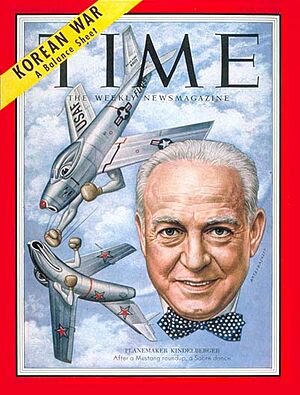James H. Kindelberger facts for kids
Quick facts for kids
James Howard Kindelberger
|
|
|---|---|
 |
|
| Born | May 8, 1895 Wheeling, West Virginia, U.S.
|
| Died | July 27, 1962 (aged 67) Pacific Palisades, California, U.S.
|
| Nationality | American |
| Other names | "Dutch" |
| Known for | North American Aviation |
James Howard "Dutch" Kindelberger (born May 8, 1895 – died July 27, 1962) was a very important American aviation pioneer. He was known for leading a big airplane company called North American Aviation for many years, from 1934 to 1960. People knew him as a hard worker who liked things to be organized and on time.
Contents
Early Life and Education
Kindelberger was born on May 8, 1895, in Wheeling, West Virginia. His father, Charles Frederick Kindelberger, worked in a steel mill. His mother was Rose Ann Kindelberger.
James left school after the 10th grade. He started working in the steel industry with his father. To learn more, he took special courses by mail. In 1916, when he was 21, he went to the Carnegie Institute of Technology. There, he studied engineering.
His nickname, 'Dutch,' came from his family's background. They were German (Deutsch) immigrants from a place called Nothweiler in Germany.
In 1919, he married Thelma Knarr. They had two children together.
Aviation Career Beginnings
During World War I, Kindelberger was part of the US Army Air Service. He worked as a pilot instructor. His base was at Park Field in Memphis, Tennessee. After the war, James wanted to work in aviation.
In 1920, he found a job with the Glenn L. Martin Company in Cleveland, Ohio. He became their chief draftsman and assistant chief engineer.
Kindelberger met J. L. "Lee" Atwood in 1930. They were both young engineers at Douglas Aircraft Company. They worked together on early passenger planes like the DC-1 and DC-2. Kindelberger became the chief engineer at Douglas. He stayed there for nine years.
In 1934, Kindelberger and Atwood left Douglas Aircraft. They moved to a company called North American Aviation (NAA). When they joined NAA, the company only had orders for one passenger plane. Kindelberger quickly helped NAA get a big order. It was for a military training plane, the North American BT-9. This order was worth $1 million. Kindelberger became the president and general manager of NAA. Atwood became the chief engineer.
Building Planes for World War II
In the summer of 1941, the United States was not yet fighting in World War II. But the British Air Ministry needed more planes. They asked North American Aviation to build Curtiss P-40 Warhawk fighters. The Curtiss factory was already making planes for the U.S. military.
Kindelberger told the British that North American could design an even better plane. He promised to build a new prototype quickly. In just four months, they finished the first version of the famous P-51 Mustang. This plane became one of the best fighter planes of the war.
By the end of World War II, North American Aviation had built a huge number of aircraft. The company produced a total of 42,000 planes.
Innovations After the War

After World War II, Atwood believed that better rocket engines would be needed. The Germans had developed rockets like the V-2. In 1946, Kindelberger and Atwood decided to invest $1 million. They built a special place to test rocket engines in Santa Susana, California. They also built a supersonic wind tunnel at Los Angeles International Airport. This tunnel helped them test planes that fly faster than sound.
This investment paid off. North American Aviation won a contract to develop the SM-64 Navaho. This was a long-range cruise missile powered by rockets.
In 1948, Kindelberger was promoted. He became the chairman and chief executive officer (CEO). Atwood took over his old role as president.
The Navaho project helped North American learn a lot. They became experts in rocket engines and inertial navigation systems. They also learned about planes that fly at supersonic speeds. This knowledge helped them get contracts for many advanced aerospace vehicles in the late 1950s. These included the X-15 spaceplane, the Hound Dog missile, and the XB-70 Valkyrie bomber. The XB-70 was a triple-sonic bomber. Building it meant the company had to create new materials and ways of welding and manufacturing.
Later Life and Legacy
In 1960, Kindelberger retired from his main roles. Atwood then became the Chief Executive. Kindelberger remained chairman of the board until he passed away. He died on July 27, 1962, at age 67. His personal doctor, Dr. Toby Freedman, was with him when he died. James Kindelberger is buried at Westwood Village Memorial Park Cemetery in Los Angeles, California. After his death, Atwood became the chairman of the board.
Under Kindelberger's leadership, North American Aviation achieved amazing things. They broke through many technology barriers. They built propeller planes, jet planes, bombers, and military trainers. They also made rocket engines and rocket-powered aircraft. The company also started its important role as a main contractor for the U.S. space program. Between 1935 and 1967, North American Aviation built more military aircraft than any other company in U.S. history.
In 1972, he was honored by being inducted into the National Aviation Hall of Fame.
The International Aerospace Hall of Fame also welcomed Kindelberger in 1977.
Kindelberger was featured in a 2006 documentary film. It was called Pioneers in Aviation: The Race to the Moon. This film showed the lives of five important U.S. aerospace pioneers. It included William Boeing, Donald Douglas, Dutch Kindelberger, Harrison Storms, and James McDonnell. The film included interviews, photos, and video of Kindelberger that had not been seen before.

